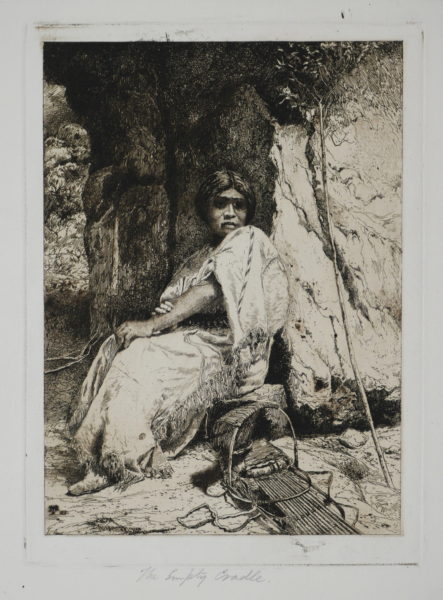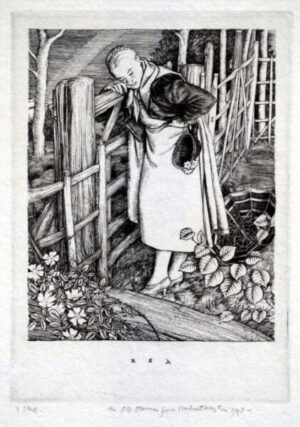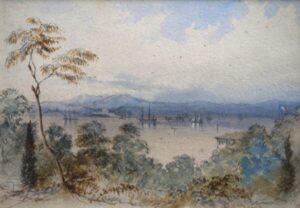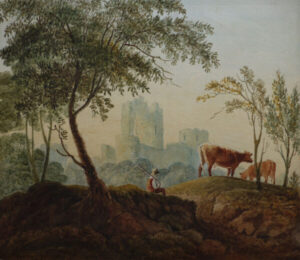Description
This print is unique in the respect that it was gifted by the artist to the noted Scottish travel writer and painter, Constance Frederica Gordon-Cumming (1837-1924). Gordon-Cumming was born into a wealthy family, she travelled around the world painting and writing on scenes and life as she saw them. She was a friend and influencer of the travel writers and artists Marianne Isabella North and Isabella Bird.
Gordon-Cumming visited Yosemite Valley in April 1878, after visiting Tahiti. She intended to visit for 3 days but ended up staying 3 months. She says “I for one have wandered far enough over the wide world to know a unique glory when I am blessed by the sight of one . . .” She published her letters back home as Granite Crags in 1884. While in Yosemite Miss Gordon-Cumming also drew watercolour sketches, which she displayed in Yosemite Valley—making it the first art exhibition in Yosemite.
In May 1882 the Moran’s sailed for the British Isles – they visited Scotland and London (where they met Francis Seymour Haden of the London Society of Painter-Etchers and John Ruskin). A year previous to this visit Mary and Thomas were invited to become fellows of the London Society of Painter-Etchers, and Moran was elected an Associate of the National Academy. Ruskin bought etchings from both the Moran’s.
Despite his inventiveness, Moran also had a strong naturalistic proclivity. He encountered photographers on many of his expeditions and commissions, and his brother John’s occupation as a photographer in Philadelphia may have led to Thomas’ incorporation of photographs into his works. The Pah-Ute Girl and The Empty Cradle were both drawn from photos taken by the German-born American, John Hillers (1843-1925) on the 1873 Powell expedition to what is now Utah and southern Arizona. Apparently, Moran arranged the poses to correspond better to nineteenth-century artistic conventions. Moreover, the costumes may have been anachronistic, for Hillers states in his diary that, on the 1873 expedition, Powell took along clothing acquired on an earlier trip in the late 1860s. Similarly, Moran produced an etching titled, The Church of San Juan, this etching was also derived from a photograph but several sketches and watercolours intervened between the photograph and the final print. The mere copying of photographs was never Moran’s aim.
Thomas Moran made more than eighty etchings during his career. Many of these etchings were of original subjects; some were etched reproductions of his own work and the work of other artists. Moran’s etchings exhibit the full extent of his creativity and inventiveness. He owned his own press and employed a wide variety of tools and techniques, various proofs reveal re-workings and a careful building of depth and tone with successive states. Moran’s etchings of original subjects were based on sketches made in the field: unlike his wife, Moran never etched directly from nature. Each won wide acclaim for their etchings, and in 1881 they were among the twelve Americans elected as “original fellows” of the Painter-Etcher’s Society of London. John Ruskin admired their work, calling Moran’s “The Resounding Sea” the “finest drawing of water in motion that had come out of America. Throughout the 1880’s Moran was widely exhibited, winning honours, awards and high critical praise. The etchings also enjoyed commercial success, with various editions selling out shortly after their publication.
Literature:
Exhibition catalogue: C. Klackner’s, New York, March 1889. A Catalogue of the Complete Etched Works of Thomas Moran and M Nimmo Moran. “The Empty Cradle” 1878. A Pah-Ute woman mourning at the cradle of her dead baby. From a photograph from life made by the etcher in Utah. Page 10. No. 9.
Exhibition catalogue: The Prints of Thomas Moran in – The Thomas Gilcrease Institute of American History and Art. Oct 1986 – Jan 1987. Pages; 80-81. No. 18, illustrated.



